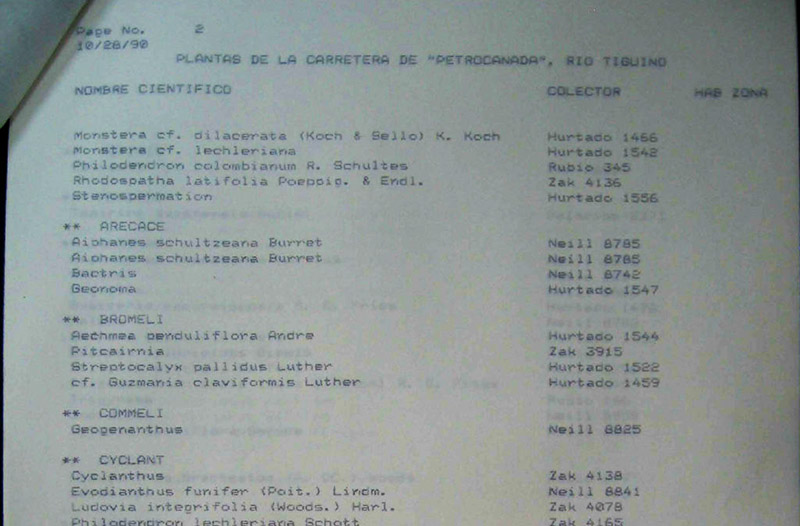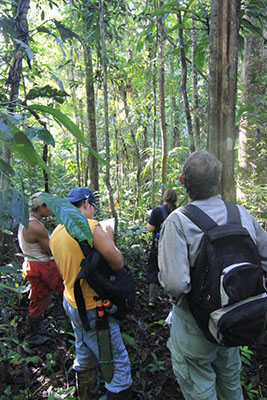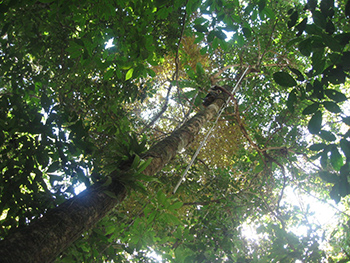Prior to the emergence of “biodiversity loss” as a ubiquitous way of talking about species extinctions in the 1990s, taxonomic biology was considered a dying field. The physical inspection of specimens to assign them to biological categories had long had a reputation as a hobby for “crusty old men and their dusty shelves”, as one botanist joked during my research in Ecuador. Biology’s cutting edge was genomics. But with an explosion of concern for a global extinction crisis, taxonomically-trained biologists and their cheap, low-tech methods occupied a central role in 1990s Latin American conservation efforts (e.g. Raven and Wilson 1991).
In this post, I briefly consider how taxonomically-oriented field biology relates to other, typically quantitative ways of evaluating biodiversity. Taxonomy played an important role in establishing where conservation should focus its efforts. An increased emphasis on quantitatively linking biodiversity to other environmental problems has meant an increased role for other kinds of expertise (Gabrys 2016). It has also meant a return to the margins for taxonomic expertise. Examining the tools used to evaluate the biotic environment sheds light, both on the different kinds of questions that can be asked about it, and on the shifting place of different kinds of expertise in environmental governance.

A vintage taxonomic list from floristic survey in the Ecuadorian Amazon, which this author can attest is largely useless to the non-specialist (all photos by the author).
Listing Life

A team of U.S. and Ecuadorian biologists surveys the location of an anticipated biological research station for the government of Pastaza Province, Ecuador.
In the 1990s, Latin American conservationists’ work involved assessing large geographic areas where human presence was thought to pose a threat to ecosystems. The emphasis was on expediently understanding what species existed in a place, rather than constructing statistically defensible sampling frames for understanding species abundance. The typical product of taxonomically-oriented fieldwork is a list of taxa associated with a given field locality.
Lists are characteristically used by bureaucracies as tools of either inventory (for property) or census (for persons). Lists “remember” the categories and quantities making up a stock of something, and they make that account available to scrutiny by multiple parties (Goody 1986). The list-as-inventory is one way that property takes shape as a formalized relationship between political institutions and resources.
Taxonomically-trained biologists, and the welter of lists they generated, were at the center of a highly historically distinct institutional arrangement (Taber 2016). Whereas classical sociology might have anticipated such a list to be associated with the bureaucracy of a territorial state (Weber 1978), international biodiversity conservation has tended to be spearheaded by networks of non-governmental organizations, bilateral aid agencies, multilateral funders and private contractors. The taxonomic list let biologists guide the conservation efforts of these networks, placing them in central roles in 1990s environmental institution-building that would have seemed highly unlikely only a decade earlier.
An Economy of Indices
Taxonomic lists quickly acquired a reputation as unwieldy managerial tools (e.g. Dinerstein et al. 1995). The field- and lab-work involved in constructing them is laborious. And while a taxonomist can use a list to make informed judgments about the biological “value” of a place, non-taxonomists – even scientists in closely aligned fields like laboratory-based biology or ecology – may find them inscrutable. Moreover, conservation’s emphasis in many places has shifted from guiding protected area design to quantitatively linking biodiversity to climate change interventions. For all these reasons, conservationists have long sought alternative ways to evaluate biodiversity.
The most common alternatives to taxonomic data are indices. To take one example, Staton et al. (2014) have recently explored the use of “bioaerosols” in assessing local biodiversity. Bioaerosols are airborne particles that originate with living things. Through a simple set of techniques they can be vacuumed up, collected in a filter, and measured to provide an estimate of their atmospheric concentration. Thus, the authors report that a sample taken in the lower Ecuadorian Amazon yielded an atmospheric concentration of roughly .32 micrograms per cubic meter of air sucked through a filter.
This number is no more intrinsically meaningful for the authors of the study than it is for readers of this blog. Interpreting it requires a frame of reference. In their small study, bioaerosol samples correlated well with vegetation measures produced using satellite imagery. On the other hand, they diverged in places with dense plant cover, perhaps due to the fact that green light reflected by chlorophyll-bearing leaves can saturate the sensor that registers green light. Bioaerosol concentration will become a useful index to the extent that it eventually occupies a clearly defined place in this larger field of statistically inter-relatable indices, with specific applications and clearly understood limitations.
If lists play recognizable, longstanding roles in formal organizations, precedents for the index are slightly harder to pinpoint. One potential analog might be the macroeconomic indicators that are now used to judge the health of national economies. Environmental indices enable (and demand) a similar kind of systems-thinking, telling specialists something indirectly about the environment that must be interpreted, partially in light of other indices.
Styles of Inference and the Ownership of Conservation

A biologist collects specimens from a tree’s lower canopy using clippers attached to a long aluminum pole, about 15 meters off the ground.
An index captures a quantitative overview of an ecosystem in an expeditious way; it facilitates tracking changes through time; and it’s interpretable through statistical inference. Taxonomy is laborious and difficult to translate across disciplinary divides. But it produces knowledge of the biotic environment’s composition in categories of self-reproducing genetic material. Taxonomy says something directly about biological diversity in a way that quantitative indices do not.
Anthropologists often view quantitative science as “antipolitical”, cordoning off a particular topic from democratic deliberation and decision-making. But the truth in this case is more complicated. Relative to taxonomically-based methods, an increased reliance on statistical inference in conservation opens up claims-making about biodiversity to mainstream ecology, biology and natural resource management. Quantitative indices are now used to link biodiversity conservation to higher-profile (and sometimes better-funded) areas like climate change mitigation, for example by measuring forest growth as a means for offsetting atmospheric carbon dioxide.
Perhaps unintuitively, the list’s exclusionary character was, and is a double-edged sword: in the 1990s, taxonomic lists gave biologists a degree of authority where they were needed, but their arcane nature also encouraged non-taxonomists to look elsewhere for tools that could be used more flexibly and across disciplinary boundaries. But while taxonomic methods are once again at the margins, they have not disappeared. Taxonomic lists are now an institutionalized component of managerial activities like environmental impact assessment in much of the world, existing awkwardly alongside quantitative methods for studying environmental change. And they continue to serve as a necessary basis for fine-grained ecological research, for example in the long-term study of forest parcels. Biodiversity conservation will have to navigate between taxonomy’s particularism and quantitative ways of reasoning about the environment for the foreseeable future.
References
Dinerstein E, Olson DM, Graham DJ, Webster AL, Primm SA, Bookbinder MP, Ledec G, & World Wildlife Fund (1995) A Conservation Assessment of the Terrestrial Ecoregions of Latin American and the Caribbean. Washington D.C.: World Bank.
Gabrys, Jennifer (2016) Program Earth: Environmental Sensing Technology and the Making of a Computational Planet. Minneapolis: U Minnesota P.
Goody, Jack (1986) The Logic of Writing and the Organization of Society. Cambridge, UK: Cambridge UP.
Raven, Peter and Wilson E. O. (1992) A fifty-year plan for biodiversity surveys. Science 258(5085): 1099-1100.
Staton, Sarah, Woodward, Andrea, Castillo, Josemar, Swing, Kelly, and Hayes, Mark (2014) Ground level environmental protein concetrations in various ecuadorian environments: Potential uses of aerosolized protein for ecological research. Ecological Indicators 48: 389-95.
Taber, Peter (2016) Taxonomic government: Ecuador’s National Herbarium and the institution of biodiversity, 1986-1996. Science & Technology Studies 29(3): 28-48.
Weber, Max (1978) Economy and Society, Vol. 2. Berkeley: U California P.
